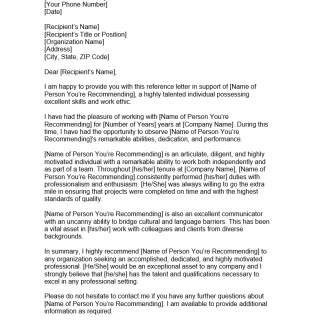Reference Letter
A reference letter, also known as a recommendation letter, is a written document in which the writer provides an assessment of the character, skills, and capabilities of a person. The purpose of a reference letter is to confirm details about the individual and provide information about their qualifications, achievements, and skills. It is usually addressed to "To Whom It May Concern" or "Dear Sir/Madam".
The letter should consist of three parts: the introduction, the body, and the conclusion. In the introduction, the writer should state their relationship with the individual and how long they have known them. The body should provide specific examples of the individual's skills and capabilities, highlighting their strengths and accomplishments. The conclusion should affirm the writer's confidence in the individual's abilities and recommend them for the position they are seeking.
The most important fields in a reference letter are the opening paragraph, the body, and the closing paragraph. In the opening paragraph, the writer should introduce themselves and explain their relationship with the individual. In the body of the letter, the writer should provide information about the individual's qualifications and accomplishments, highlighting their strengths and achievements. In the closing paragraph, the writer should affirm their confidence in the individual's ability to succeed in the position they are seeking.
Reference Letter Sample
[Your Name]
[Your Address]
[Your City, State, ZIP Code]
[Your Email Address]
[Your Phone Number]
[Date][Recipient’s Name]
[Recipient’s Title or Position]
[Organization Name]
[Address]
[City, State, ZIP Code]Dear [Recipient’s Name],
I am happy to provide you with this reference letter in support of [Name of Person You’re Recommending], a highly talented individual possessing excellent skills and work ethic.
I have had the pleasure of working with [Name of Person You’re Recommending] for [Number of Years] years at [Company Name]. During this time, I have had the opportunity to observe [Name of Person You’re Recommending]’s remarkable abilities, dedication, and performance.
[Name of Person You’re Recommending] is an articulate, diligent, and highly motivated individual with a remarkable ability to work both independently and as part of a team. Throughout [his/her] tenure at [Company Name], [Name of Person You’re Recommending] consistently performed [his/her] duties with professionalism and enthusiasm. [He/She] was always willing to go the extra mile in ensuring that projects were completed on time and with the highest standards of quality.
[Name of Person You’re Recommending] is also an excellent communicator with an uncanny ability to bridge cultural and language barriers. This has been a vital asset in [his/her] work with colleagues and clients from diverse backgrounds.
In summary, I highly recommend [Name of Person You’re Recommending] to any organization seeking an accomplished, dedicated, and highly motivated professional. [He/She] would be an exceptional asset to any company and I strongly believe that [he/she] has the talent and qualifications necessary to excel in any professional setting.
Please do not hesitate to contact me if you have any further questions about [Name of Person You’re Recommending]. I am available to provide additional information as required.
Sincerely,
[Your Signature]
[Your Name]
Reference letters are usually compiled when an individual is seeking employment or admission to a college program. The parties to the document are the writer of the letter and the individual seeking the recommendation. The features that should be considered when compiling a reference letter include the tone, the content, and the length of the letter.
The advantages of a reference letter are numerous, including providing confirmation of qualifications, character, and capabilities of the individual, serving as an endorsement of the individual by a credible source, and increasing the chances of success in obtaining the position or admission being sought.
The problem with filling out a reference letter is making sure that the information provided is accurate, truthful, and unbiased. Also, ensuring that the letter is written in a way that is appropriate for the position or admission being sought.
Related forms include letters of recommendation, personal references, employment references, and academic references. These forms differ from reference letters in that they are usually more specific to the purpose of the document.
Reference letters are usually submitted as hard copies or electronic copies to the individual or organization requesting them. The instances of the form are stored by the writer and the individual seeking the recommendation.

